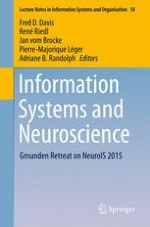2015 | Buch
Information Systems and Neuroscience
Gmunden Retreat on NeuroIS 2015
herausgegeben von: Fred D. Davis, René Riedl, Jan vom Brocke, Pierre-Majorique Léger, Adriane B. Randolph
Verlag: Springer International Publishing
Buchreihe : Lecture Notes in Information Systems and Organisation
